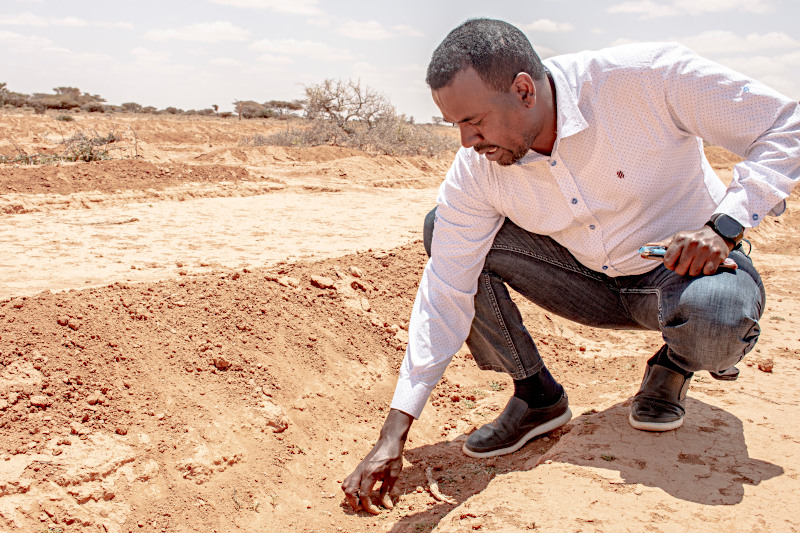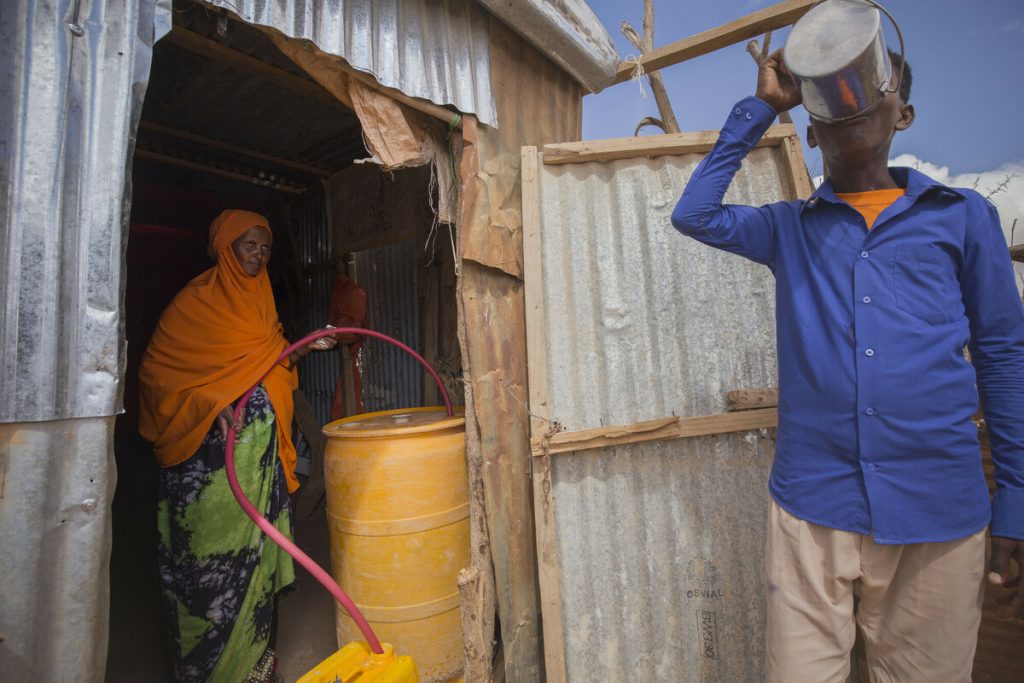As East Africa faces drought and famine, Jessica Fullwood-Thomas talks to Oxfam in Somalia’s Muktar Hassen about a crucial lesson from the 2017 food crisis: that the region needs a “triple nexus” approach across humanitarian response, development and peace work to deliver sustained change

In seven years at Oxfam in Somalia, Muktar Hassen has seen first-hand how drought and conflict are driving a protracted crisis. This year, the country is facing its fourth season of failed rains with the current drought predicted to leave 4.5 million Somalis in need of urgent humanitarian assistance. Yet the 2022 Humanitarian Response Plan is only 3.8% funded.
On a recent visit to the country I spoke to Muktar, currently Oxfam’s Emergency Food Security and Vulnerable Livelihoods Advisor with responsibility for Nexus and Resilience, about the scale of the challenge his team faces – and how they are trying to create a mindset of “triple nexus as standard practice”, breaking down the historic silos of humanitarian, development and peace programming as they work towards a vision of a Somalia that can live with drought.
Muktar, you have been working with Oxfam Somalia for seven years: how has Oxfam’s approach changed in that time?
When I joined Oxfam, our focus was working on humanitarian only. However, the 2017-18 East Africa food crisis was a wake-up call. It was clear that pure humanitarian didn’t work any more because of the increase in frequency and scale of the shocks communities faced.
So, Oxfam Somalia decided to combine its humanitarian and resilience work. We started by integrating community-based early recovery and prevention activities. We also invested in early warning and early action, capitalising on mobile phone penetration in Somalia to set up a platform that provided communities with timely, accurate weather forecasting to inform their livelihood decision-making. However, we realised we needed to go further, towards resilience-building and layering different interventions to find sustainable solutions.
As time has passed, we have built more resilience investment. Silos can still be a barrier in Oxfam but substantial progress has been made in mixing resilience, recovery and humanitarian.
The SOMREP programme [a multi-agency programme that aims to build resilience to climate shocks by 2023] has been critical for innovation and for learning over time what works across differing contexts in Somalia. Comprehensive contextual analysis has been key to ensuring we plan for the full range of natural hazards and human-made risks when designing projects. In addition, internal changes such as Oxfam moving to a single management system and the availability of unrestricted funds has been instrumental in breaking silos driven by separate funding streams.
Triple nexus ways of working are high on the agenda across the sector. Oxfam has been a thought leader in this space and positioned itself as investing in triple nexus as an approach for enhanced humanitarian action. We need to capitalise on this and push further and faster towards integrated programming.
‘Our affiliates and donor communities need to walk the talk on triple nexus funding, and focus on climate adaptation, smart agriculture, partnerships and accountability’
Muktar Hassen
Partnerships have been key: Oxfam Somalia works collaboratively with local organisations to ensure communities receive holistic support and bigger outreach. We have made important commitments around funding flows to partners to live up to our Grand Bargain commitments and this is both right and productive, as it often leads to better designed and delivered programming that is context-specific.
We have built and must continue to build effective working relationships with women’s rights organisations (WROs) and peacebuilding specialists to ensure do-no-harm and conflict-sensitive interventions. Working together to raise the voices and asks of those most affected by crises must also be a priority through joint influencing and innovative localised campaigning. We have pushed, and will continue to push, for change from donors and governments on the burden of funding, contracting and reporting expectations on WROs and other partner organisations.

What do you think is working about your current programming approach?
The commitment is there. Oxfam in Somalia has stated in its new 10-year plan that we will support humanitarian programs that integrate a triple nexus approach. This is already taking shape as we’ve been layering different projects in the same area in Sanaag, which has been a critical testing ground for us.
In El-afweyn, a village affected by frequent clan conflict, Oxfam combined multiple humanitarian funding sources to establish a water desalination unit and rehabilitate a high-yielding shallow well. With resilience funding, we built a pipeline to service an irrigation channel which now provides water for fields where (agro)pastoralists started farming. Women-led village savings and loans associations (VLSAs) ensure that small businesses thrive; women are also part of agricultural activities such as fodder production.
Helped by unrestricted funding, we have complemented these activities with local peace committees to build local capacities for peace. We have also attracted new funding from SomRep, where Oxfam is a consortium member, and flexible funding from Oxfam GB to increase our work across humanitarian and resilience, with more exciting opportunities in the pipeline.
This is giving us more and more evidence for what works and making the case for investment in resilience and peacebuilding with donors. We are now doing a learning review that will guide the development of a new triple nexus strategy for the next five years.
So what is missing?
We need to look inwards and ask tough questions. We are making progress but upskilling will be necessary if Oxfam Somalia is to fully shift its mindset to triple nexus as standard practice. Our affiliates and donor communities also need to walk the talk on triple nexus funding, and increase their investment in activities like climate adaptation financing, smart agriculture, partnerships and accountability.
As part of this we need to better understand the value Oxfam can bring and establish partnerships with those local actors who are best placed to design and deliver complementary interventions across humanitarian, development and peace. We need to facilitate local voices to participate in aid system discussions and listen and learn on localised solutions to inclusive and sustainable peace. This will be even more important as we expand our footprint into Puntland and South Central Somalia to ensure our interventions are tailored to those contexts.
‘We should commit to no longer chasing standalone emergency funding: rather we have to ensure that humanitarian, resilience and peace always go side by side’
Muktar Hassen
Funding will remain a challenge: not enough of it is longer-term and flexible to effectively meet the needs and aspirations of communities in Somalia. Internally Oxfam has made positive changes around the multi-year use of unrestricted income and decentralising decision-making to ensure local knowledge is centred. But this needs to be replicated across the board.
There must be predictable flexible, multi-year funding that enables us to plan properly, implement long-term visions and deliver on our commitments to communities. I hope Oxfam can communicate this need for longer-term, flexible funds to our supporters.
What is your vision for the next 10 years for how Oxfam and partners can better meet the immediate and longer-term needs of people across Somalia?
My aspiration for Somalia is a place where the impacts of droughts are not felt at community level. A Somalia adapted to, and living with, drought. To achieve this, we need to support diversified livelihoods and climate-sensitive sustainable living behaviours. We should commit to no longer chasing standalone emergency funding or single-input projects [projects that only address a single aspect of development such as education or are setup to tackle only one type of hazard or risk]: rather we have to ensure that humanitarian, resilience and peace always go side by side. This means a big push on influencing, to share what works and get others to walk the talk on finding lasting solutions through working across humanitarian, development and peace.
I would like to see Oxfam Somalia continue with its partnership model and go further. To establish ways of working that ensure collaboration that achieves impact by making the most of each partner’s different skills and knowledge. We also need to engage other stakeholders including governments to respond better to the context and to ensure that we don’t perpetuate aid dependency, which is a big risk in protracted crises.
Want to find out more? Read Oxfam GB’s recent statement calling on the UK government to act now to avert famine in East Africa; our reaction to the recent announcement of new UK aid for Somalia; and find out more about and donate to our East Africa crisis appeal